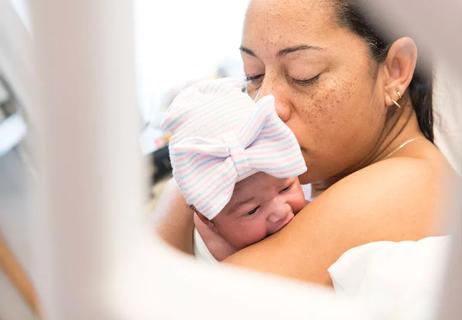You can plan for almost anything, but be flexible about the outcome

We all conjure up best-case scenarios and envision just how we’d like the birthing process to go. But we can’t always account for every twist and turn imaginable. When you’re caught up in the middle of labor and delivery, events can happen quickly. Making decisions in the moment can sometimes be challenging, especially when we’re unsure of what to expect or unexpected circumstances pop up.
Advertisement
Cleveland Clinic is a non-profit academic medical center. Advertising on our site helps support our mission. We do not endorse non-Cleveland Clinic products or services. Policy
But you can still prepare for what’s ahead and aim for the best-case scenario by creating a birth plan. Birth plans detail your wishes and preferences for what will happen when you’re giving birth. They also specify the kinds of interventions and techniques you want your healthcare team to use during the labor and delivery process.
Certified nurse midwife Claire Hamp, CNM, explains how to create a birth plan, how it can help ensure you and your healthcare providers are on the same page, and why it’s OK to be flexible when things don’t exactly go the way you expected.
A birth plan is a summary of your preferences for how you want to give birth and what you want to happen during labor and delivery. These plans include your preferences for pain management and the postpartum (after birth) care you want for you and your baby.
You can think of your birth plan as a set of guidelines or a map you want your healthcare team to follow. By identifying your preferences in a birth plan, your doctor or midwife has the best path forward to make the experience of labor and delivery safe and comfortable for you.
“When you have ideas for your birth plan, bring them to appointments because your healthcare provider can talk through each section with you, clarify what is already a part of their practice, what they can definitely do, things they may not be able to do, or things they can compromise on and do part of,” says Hamp.
Advertisement
“Those discussions with your healthcare provider really help with education and understanding when things are needed, and those conversations also give your healthcare provider a good understanding of what you’re looking for.”
A birth plan is important because it helps clarify all of the possible options that are available to you for care and interventions during labor and delivery. But like following any road map, when unexpected events pop up, you sometimes need to take an alternative route to your destination.
For example, if you experience more pain than you initially expected or if you need to be repositioned during delivery, your birth plan outlines alternative methods you’re comfortable using. It also outlines the different tools and techniques you’d like your healthcare provider to use should the need arise. That’s where creating a birth plan and talking it through with your healthcare provider becomes important. A birth plan allows you to work together as a team. It’s also why it’s incredibly helpful to be flexible with your plans and your expected outcomes.
“I really think of birth plans like a summary of what you’re thinking for labor,” says Hamp. “I describe all these options as a person’s toolbox. You have all these options that can help support your labor, but you don’t have to use them or you don’t necessarily always need them. It’s just good to know that they’re there.”
Birth plans vary in the way they’re set up, but in general, you want to keep it short and easy to read on one page. Your birth plan should also include the following sections:
You want to start with an introduction that includes your name, the location you’ll be giving birth, name and contact information of your healthcare provider, and any medical conditions that should be listed on your chart or notified to your healthcare team. If you’re working with a doula, you want to list their name and contact information as well.
As part of this introduction, you also want to list what kind of delivery you’re planning for, which may include:
In the event that your team needs to pivot and use an alternative delivery method, it’s good to list backup options that you’re comfortable having if delivery becomes difficult. For example, in most cases, an episiotomy isn’t needed, but it may sometimes be considered if your baby is in distress or forceps and vacuum are needed to help with the delivery process. If you don’t want these procedures done, make sure you list them and talk to your healthcare provider about your concerns. If you’re OK using these alternative methods in the case of an emergency, make sure you note that, too.
Advertisement
This section could benefit from a thorough discussion with your healthcare provider. Most notably, it’s important to realize that whether you choose to have a medicated or unmedicated delivery, your birthing decisions matter.
“All birth is birth,” notes Hamp. “The experience of labor and delivery can sometimes be similar to the reasons why someone may want to run a marathon. Some want to know that they can do it and they want the satisfaction of physically feeling and working through their labor. But no one way is better than the other.”
Unmedicated delivery options that can help with pain management include:
“There are different labor circuits and labor positions you can do, and movement can take pressure off of parts of your body where you might be feeling more pain and more intensity,” explains Hamp. “Movement helps with repositioning the fetus and helps open your pelvis in different ways.”
Medicated delivery options include:
“I encourage everyone, whether they think they want an epidural or not, to have a plan for coping with labor pain and discomfort from contractions because depending on what else is happening in the labor and delivery unit, it could take some time to get an epidural even if you know you want it and you’ve asked for it,” says Hamp.
Advertisement
“Sometimes, women will even go in and their goal is to not have an epidural, but then based on the circumstances of their labor, they might get really tired and they choose to get an epidural as a tool to help them rest and help them continue and move forward in their labor process.”
Knowing your preferences ahead of time and talking with your healthcare provider about alternatives you’re comfortable using for pain management can help plan for any and all potential outcomes.
You have a say in making sure your delivery room is a safe space. Some of your options include:
“Sometimes, when labor starts at home and you arrive at the hospital, everything slows down because you’re not in your comfortable, safe place. You’re in a place with bright lights and it’s a little bit more sterile and there’s a lot more people,” notes Hamp. “Birth tends to progress in a calm environment and making sure your environment is safe, relaxing and calming can help.”
Advertisement
If you’ve scheduled a planned C-section, you can decide whether or not you want to be awake for the procedure. Healthcare providers often recommend being awake because it’s safer and helps with a faster recovery time.
If you have a C-section, you may not be able to hold your baby right away. Instead, you may need assistance from your support team. Having them bring a camera to take a picture of your baby and your baby’s weight is an important choice for many people. And skin-to-skin contact is still an option, though it may be delayed depending on how the procedure goes.
Doctors can induce labor with the help of medications or other unmedicated techniques like a Foley bulb. Sometimes, they’ll need to induce labor if you grow too tired or complications arise. But if you have a planned induction, you’ll want to keep in mind that the labor process can still take time.
“Bringing those comfort items like a pillow or a blanket, maybe even your own clothes instead of the hospital gown, can really help while you’re in labor,” advises Hamp. “Bringing a really long phone charger is always helpful, too.”
And then, there are options that consider what happens to you and your baby in those first few moments after birth, including:
There’s no shortage of birth plan templates out there on the internet, but this one from the American College of Obstetricians and Gynecologists covers all the bases in a downloadable and printable PDF.
“If you need help getting started, reading books about pregnancy and birth, talking to loved ones about their experiences and taking a childbirth education class online or with your hospital group can be helpful,” encourages Hamp.
“Those classes teach you what labor might look like, what labor at a hospital might look like and how we monitor you and your baby, what medications might be needed — all of these details that are really hard to learn unless you have gone through it yourself or have taken a class.”
Learn more about our editorial process.
Advertisement

Placenta consumption hasn’t been shown to have any health benefits, but it can cause infections

Sitting, squatting and side-lying may provide a more comfortable labor and delivery

Use relaxation techniques and breathwork to help manage the discomforts of a medication-free birth

Rinses, sitz baths, ice and medication can help the healing

Babies aren’t great about scheduling, so be sure to pack a month or two before your due date

An expert explains delayed cord clamping, including risks and benefits

There are risks to having a C-section and benefits to vaginal birth

What to expect after having surgery

The best parenting style balances enforcing rules and showing plenty of love

Tips include cutting back on sugar, focusing on exercise and managing stress

It can be harder to let go when you’ve invested time, energy and emotions — but it might be the healthier choice long term